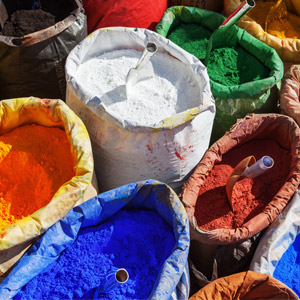Natural coloring with help of pigments
Pigments and other ingredients of our natural paints
Every paint, natural paints included, basically consists of five components: colorants (dyes of chemical origin or natural color pigments), filler media, binders, solvents and possible additives, for example, additives to achieve a faster drying.
The difference between chemical paints and natural paints
The hue of a chemically synthesized paint is based on soluble colorants, that color the filler medium of the paint. In contrast, in the production of natural paints pigments are used. These can be divided into organic and inorganic pigments. The color effect of natural colors is caused by the absorption and reflectance or the scattering and reflection of the impinging light.
Pigments - more than just color
The positive characteristics of color pigments go beyond the natural coloration: For example, the use of special pigments can achieve a vapor permeability or corrosion protection. Masonry, mineral plasters or wood can only "breathe" with help of those paints which that way create a pleasant indoor climate. Other color pigments in turn reflect the UV radiation, which is why they are used especially in the outside area on facades or on exterior wood. Applied to wood, those pigments protect the lignin contained in the wood and thus avoid its decay. In addition, the aforementioned vapor permeability supports the longevity of the treated materials.
- Iron oxide:
Iron oxides are prepared synthetically in order to achieve high levels of purity. The naturally occurring iron oxide pigments, often called "earth pigments", always contain admixtures of other compounds, in some cases unwanted heavy metals. Depending on the type of iron oxide (and its hydroxide content) the color of the iron oxide pigments varies: from yellow (ocher) to red (English red, Indian red and Persian red) to brown (umbra) and to black (iron oxide black). Finely ground iron oxides have the property of reflecting UV radiation. They are particularly lightfast, weather resistant, water-insoluble and thus ideally suited as an ingredient in paints for the outside areat. - Titanium dioxide:
Titanium dioxide (titanium white) is the most important white pigment and is used primarily in wall colors, but also in printing inks and in the paper and textile industry. Because of its safety it is also used for lipsticks, creams, makeup and powders. - Ultramarine blue:
Natural ultramarine pigments are extracted from the semi-precious stone "lapis lazuli". This stone is a complex sulfur-containing aluminum silicate, which occurs in good quality in only one locality in northern Afghanistan. Since the blue semi-precious stone originally comes from across the sea (ultra mare), it has received the name "ultramarine blue". The synthetic production was achieved independently in 1828 by the three chemists Giumet, Gmelin and Köttig. - Sunny yellow:
Bismuth vanadate is a bright yellow pigment. It is safe for humans and the environment unlike other inorganic yellow pigments such as Barytgelb (barium), cadmium yellow (cadmium sulfide) and orpiment (arsenic sulfide).. - Chromium oxide green:
The element chromium received its name because of the color of its salts (based on the Greek word chromos ["color"]). Nowadays chromium oxide Cr2O3 is the most important inorganic green pigment which can be used safely.. - Lamp black:
Soot is a long known black pigment. It is a very fine carbon that results from the incomplete combustion of organic material. Besides the use in paints and coatings, it is also used in the medical sector, for example, as charcoal tablets. - Chalk:
The sedimentary rocks of chalk (calcium carbonate) developed around 100 million years ago from the calcite shells of tiny, dead sea animals. The white pigment is mainly used as a filler in emulsion paints and wall fillers. - Zinc Carbonate:
Zinc carbonate can be found in form of the mineral "Smithsonit" especially in Namibia and Zambia. It is used as a white pigment in the paint and textile industry.
Zinc, for example, is known among many homeowners, since it has a high rust protection. This effect is used in natural paints by adding the pigment zinc phosphate. Compared to conventional anticorrosion paints this antirust paint contains no hazardous chromium. All pigments that LIVOS uses in its glazes, paints and protective coatings convince through meaningful effects that are well targeted.
Natural paint as sustainable, healthy alternative
In addition to the excellent effects on buildings, construction chemicals and coloring the biggest advantage of natural paints is its harmlessness to humans. The building structure remains healthy, the indoor climate is regulated and there is no health risk for the residents. Moreover, most natural paints are low in allergens so that our product line LIVOS neutral is an excellent choice for allergy sufferers, MCS patients, extremely odor-sensitive people and persons that are ill due to environmental reasons.
We do not leave you alone - Advice from professionals
Are you interested in further information about the ingredients of our natural paints or do you need more detailed advice for choosing the right products? We are looking forward to hearing from you by e-mail or by telephone: +49 (0) 5825 88-30.
Your LIVOS service team
Photo Credits: 81835177 © Christian Müller - Fotolia.com


